bonnet Citroen BERLINGO 2012 2.G Owner's Manual
[x] Cancel search | Manufacturer: CITROEN, Model Year: 2012, Model line: BERLINGO, Model: Citroen BERLINGO 2012 2.GPages: 208, PDF Size: 6.67 MB
Page 5 of 208
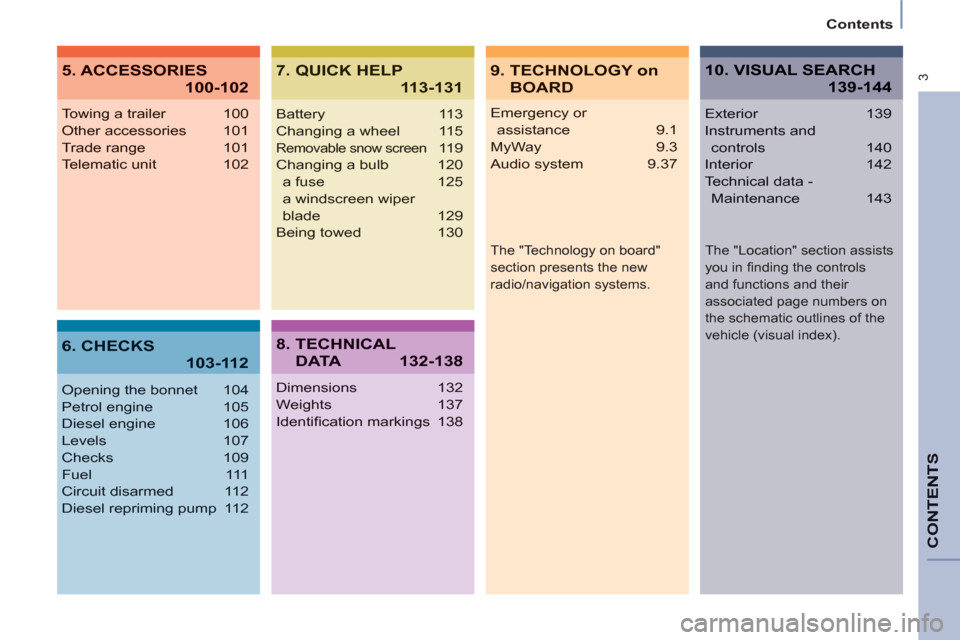
3
Contents
CONTENT
S
Emergency or
assistance 9.1
MyWay 9.3
Audio system 9.37
Towing a trailer 100
Other accessories 101
Trade range 101
Telematic unit 102
Opening the bonnet 104
Petrol engine 105
Diesel engine 106
Levels 107
Checks 109
Fuel 111
Circuit disarmed 112
Diesel repriming pump 112
Battery 113
Changing a wheel 115
Removable snow screen119
Changing a bulb 120
a fuse 125
a windscreen wiper
blade 129
Being towed 130
Dimensions 132
Weights 137
Identifi cation markings 138
Exterior 139
Instruments and
controls 140
Interior 142
Technical data -
Maintenance 143
9. TECHNOLOGY on
BOARD
5. ACCESSORIES
100-102
7. QUICK HELP
113-131
10. VISUAL SEARCH
139-144
6. CHECKS
103-112
8. TECHNICAL
D ATA132-138
The "Location" section assists
you in fi nding the controls
and functions and their
associated page numbers on
the schematic outlines of the
vehicle (visual index).
The "Technology on board"
section presents the new
radio/navigation systems.
Page 9 of 208

2c
2e
2b7a4
5
7b
2a6
5
82d
7
1
FAMILIARISATION
Exterior
17
22 25
Key
:
chapter identifi cation
: page identifi cation
82
86
Grip control
Changing bulbs
120 104
Opening the bonnet
Parking sensors
Business equipment - Accessories
101 21
Key - Remote control
Side-hinged rear doors
Sliding side door
Tailgate and rear screen
Useable dimensions
132
Spare wheel
115
24
Rear roof fl ap
Page 10 of 208
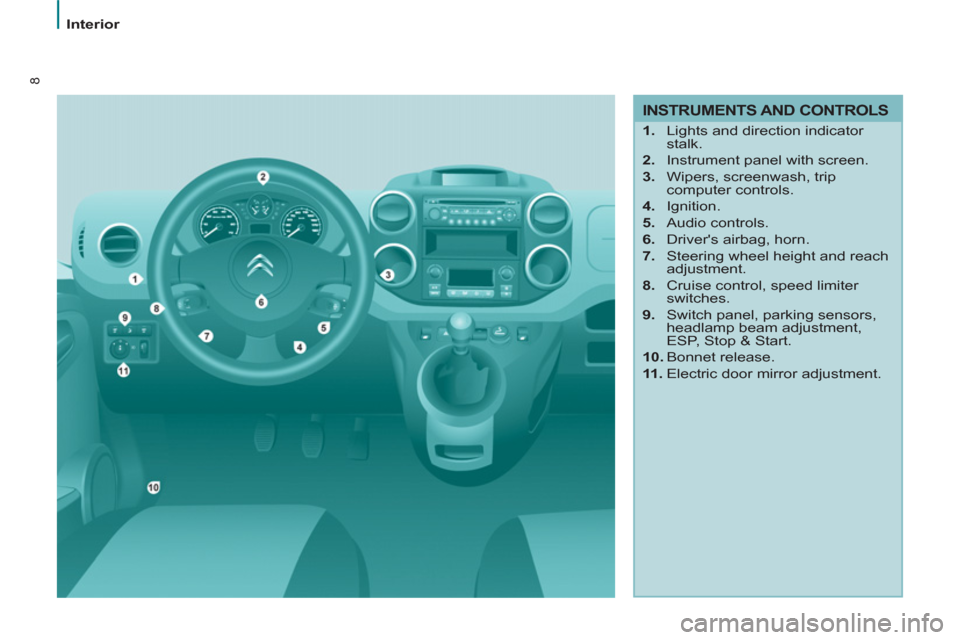
8
Interior
INSTRUMENTS AND CONTROLS
1.
Lights and direction indicator
stalk.
2.
Instrument panel with screen.
3.
Wipers, screenwash, trip
computer controls.
4.
Ignition.
5.
Audio controls.
6.
Driver's airbag, horn.
7.
Steering wheel height and reach
adjustment.
8.
Cruise control, speed limiter
switches.
9.
Switch panel, parking sensors,
headlamp beam adjustment,
ESP, Stop & Start.
10.
Bonnet release.
11 .
Electric door mirror adjustment.
Page 47 of 208
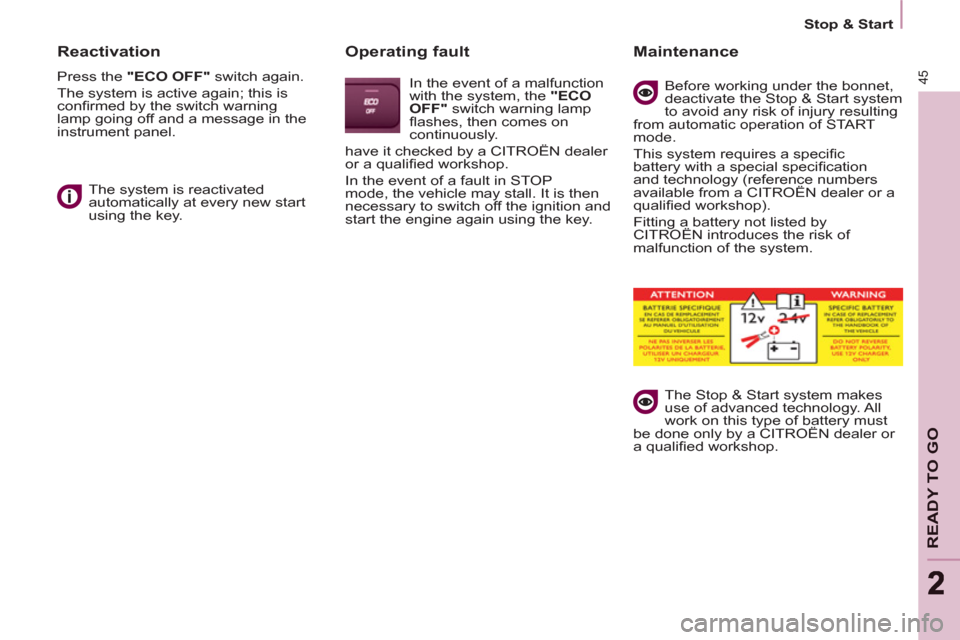
45
READY TO GO
22
Stop & Start
Reactivation
Press the "ECO OFF"
switch again.
The system is active again; this is
confi rmed by the switch warning
lamp going off and a message in the
instrument panel.
The system is reactivated
automatically at every new start
using the key.
Operating fault
In the event of a malfunction
with the system, the "ECO
OFF"
switch warning lamp
fl ashes, then comes on
continuously.
have it checked by a CITROËN dealer
or a qualifi ed workshop.
In the event of a fault in STOP
mode, the vehicle may stall. It is then
necessary to switch off the ignition and
start the engine again using the key.
Maintenance
Before working under the bonnet,
deactivate the Stop & Start system
to avoid any risk of injury resulting
from automatic operation of START
mode.
This system requires a specifi c
battery with a special specifi cation
and technology (reference numbers
available from a CITROËN dealer or a
qualifi ed workshop).
Fitting a battery not listed by
CITROËN introduces the risk of
malfunction of the system.
The Stop & Start system makes
use of advanced technology. All
work on this type of battery must
be done only by a CITROËN dealer or
a qualifi ed workshop.
Page 48 of 208
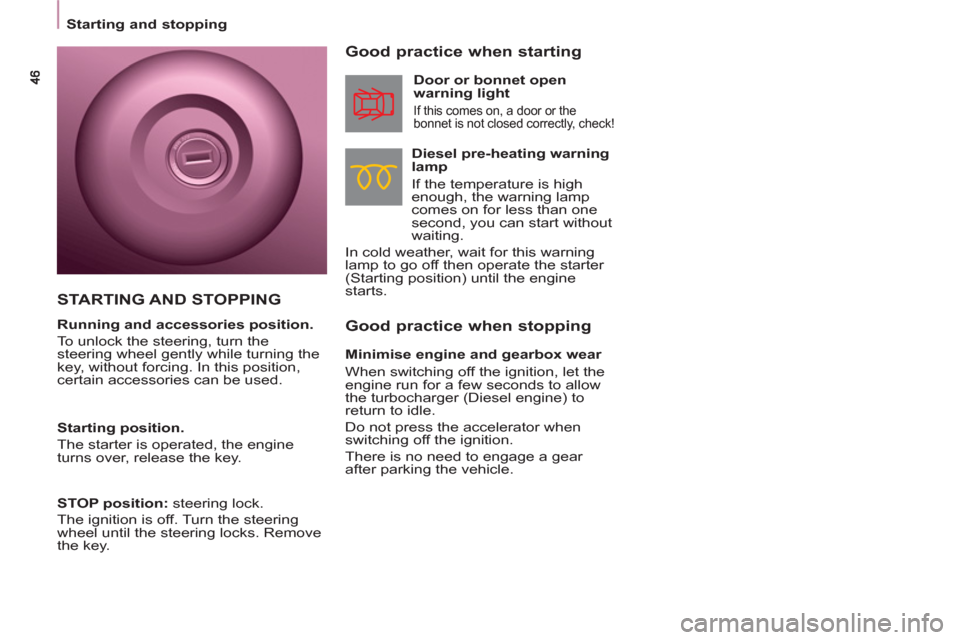
Starting and stopping
Good practice when stopping
Good practice when starting
Diesel pre-heating warning
lamp
If the temperature is high
enough, the warning lamp
comes on for less than one
second, you can start without
waiting.
In cold weather, wait for this warning
lamp to go off then operate the starter
(Starting position) until the engine
starts.
Door or bonnet open
warning light
If this comes on, a door or the
bonnet is not closed correctly, check!
Minimise engine and gearbox wear
When switching off the ignition, let the
engine run for a few seconds to allow
the turbocharger (Diesel engine) to
return to idle.
Do not press the accelerator when
switching off the ignition.
There is no need to engage a gear
after parking the vehicle.
STARTING AND STOPPING
Running and accessories position.
To unlock the steering, turn the
steering wheel gently while turning the
key, without forcing. In this position,
certain accessories can be used.
Starting position.
The starter is operated, the engine
turns over, release the key.
STOP position:
steering lock.
The ignition is off. Turn the steering
wheel until the steering locks. Remove
the key.
Page 106 of 208
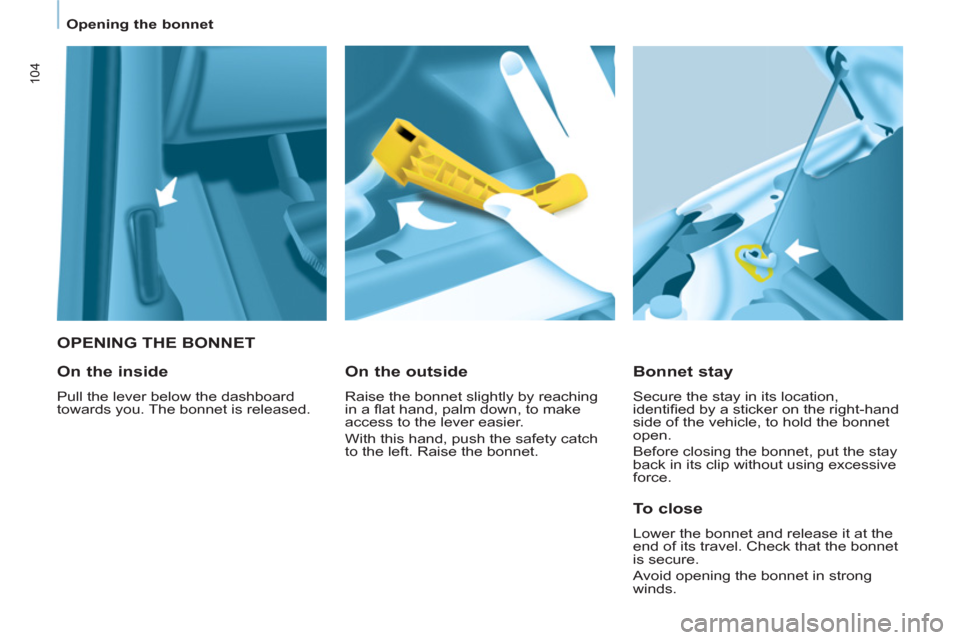
104
Opening the bonnet
OPENING THE BONNET
Bonnet stay
Secure the stay in its location,
identifi ed by a sticker on the right-hand
side of the vehicle, to hold the bonnet
open.
Before closing the bonnet, put the stay
back in its clip without using excessive
force.
On the outside
Raise the bonnet slightly by reaching
in a fl at hand, palm down, to make
access to the lever easier.
With this hand, push the safety catch
to the left. Raise the bonnet.
On the inside
Pull the lever below the dashboard
towards you. The bonnet is released.
To close
Lower the bonnet and release it at the
end of its travel. Check that the bonnet
is secure.
Avoid opening the bonnet in strong
winds.
Page 107 of 208
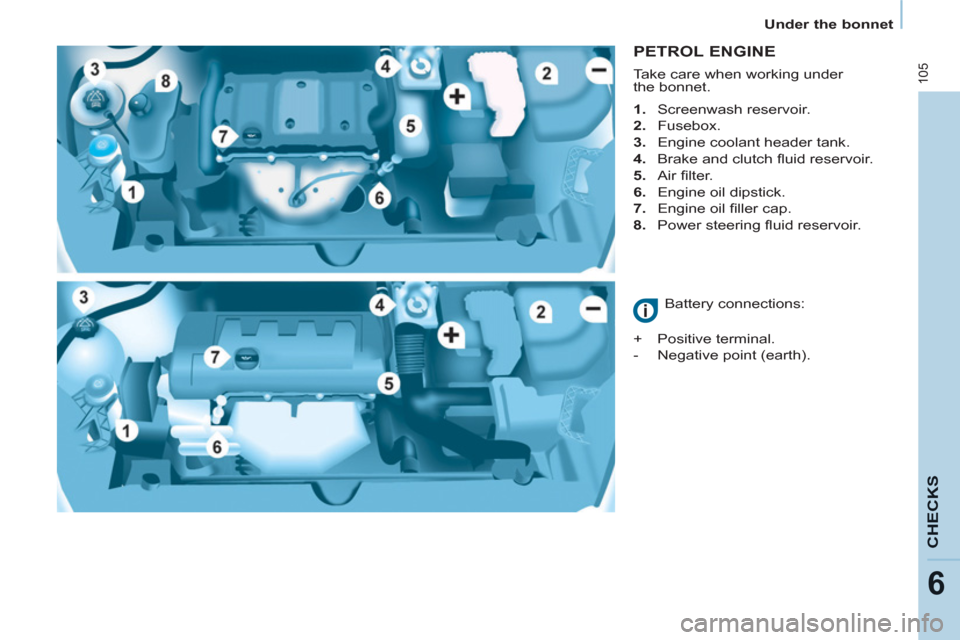
105
CHECK
S
6
Under the bonnet
PETROL ENGINE
1.
Screenwash reservoir.
2.
Fusebox.
3.
Engine coolant header tank.
4.
Brake and clutch fl uid reservoir.
5.
Air fi lter.
6.
Engine oil dipstick.
7.
Engine oil fi ller cap.
8.
Power steering fl uid reservoir.
Battery connections:
+ Positive terminal.
- Negative point (earth). Take care when working under
the bonnet.
Page 108 of 208
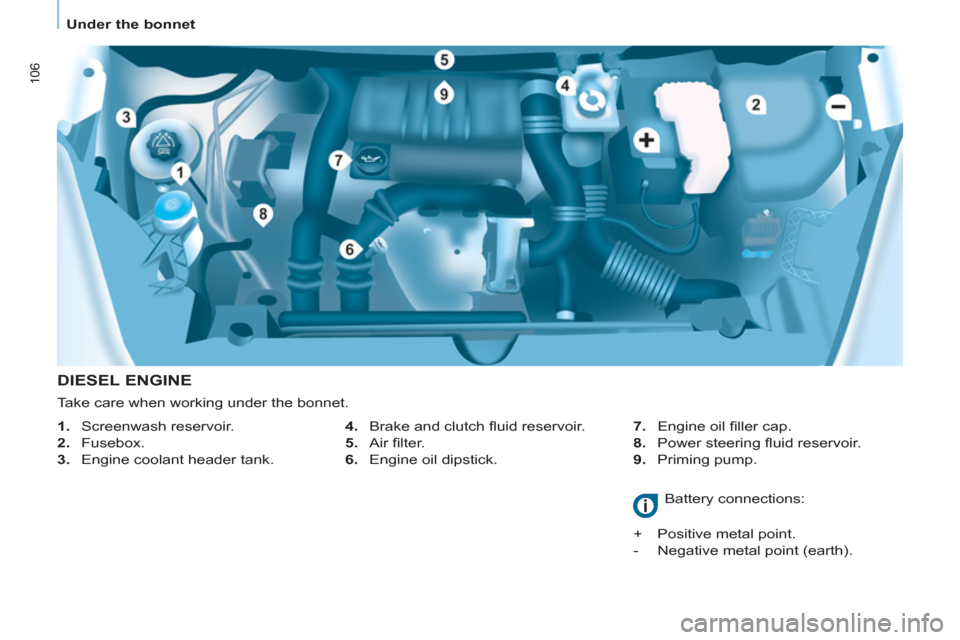
106
Under the bonnet
DIESEL ENGINE
4.
Brake and clutch fl uid reservoir.
5.
Air fi lter.
6.
Engine oil dipstick.
7.
Engine oil fi ller cap.
8.
Power steering fl uid reservoir.
9.
Priming pump.
1.
Screenwash reservoir.
2.
Fusebox.
3.
Engine coolant header tank.
Battery connections:
+ Positive metal point.
- Negative metal point (earth). Take care when working under the bonnet.
Page 109 of 208
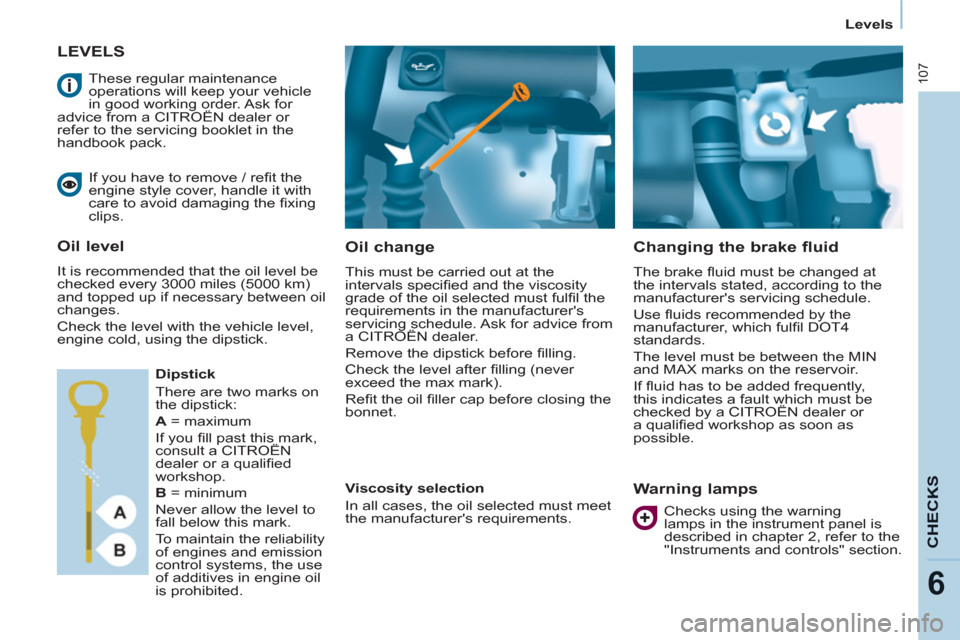
107
CHECK
S
6
Levels
LEVELS
Oil change
This must be carried out at the
intervals specifi ed and the viscosity
grade of the oil selected must fulfi l the
requirements in the manufacturer's
servicing schedule. Ask for advice from
a CITROËN dealer.
Remove the dipstick before fi lling.
Check the level after fi lling (never
exceed the max mark).
Refi t the oil fi ller cap before closing the
bonnet.
Changing the brake fluid
The brake fl uid must be changed at
the intervals stated, according to the
manufacturer's servicing schedule.
Use fl uids recommended by the
manufacturer, which fulfi l DOT4
standards.
The level must be between the MIN
and MAX marks on the reservoir.
If fl uid has to be added frequently,
this indicates a fault which must be
checked by a CITROËN dealer or
a qualifi ed workshop as soon as
possible.
Warning lamps
If you have to remove / refi t the
engine style cover, handle it with
care to avoid damaging the fi xing
clips.
Oil level
It is recommended that the oil level be
checked every 3000 miles (5000 km)
and topped up if necessary between oil
changes.
Check the level with the vehicle level,
engine cold, using the dipstick.
Dipstick
There are two marks on
the dipstick:
A
= maximum
If you fi ll past this mark,
consult a CITROËN
dealer or a qualifi ed
workshop.
B
= minimum
Never allow the level to
fall below this mark.
To maintain the reliability
of engines and emission
control systems, the use
of additives in engine oil
is prohibited.
Viscosity selection
In all cases, the oil selected must meet
the manufacturer's requirements.
These regular maintenance
operations will keep your vehicle
in good working order. Ask for
advice from a CITROËN dealer or
refer to the servicing booklet in the
handbook pack.
Checks using the warning
lamps in the instrument panel is
described in chapter 2, refer to the
"Instruments and controls" section.
Page 114 of 208
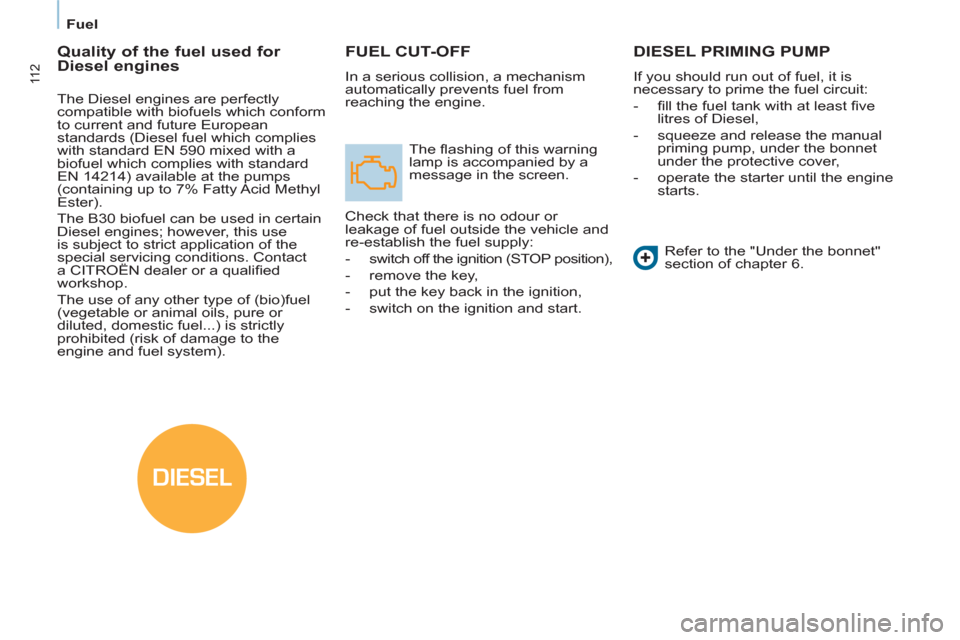
DIESEL
11 2
Fuel
FUEL CUT-OFF
In a serious collision, a mechanism
automatically prevents fuel from
reaching the engine.
The fl ashing of this warning
lamp is accompanied by a
message in the screen.
Check that there is no odour or
leakage of fuel outside the vehicle and
re-establish the fuel supply:
- switch off the ignition (STOP position),
- remove the key,
- put the key back in the ignition,
- switch on the ignition and start.
DIESEL PRIMING PUMP
If you should run out of fuel, it is
necessary to prime the fuel circuit:
- fi ll the fuel tank with at least fi ve
litres of Diesel,
- squeeze and release the manual
priming pump, under the bonnet
under the protective cover,
- operate the starter until the engine
starts.
Refer to the "Under the bonnet"
section of chapter 6.
Quality of the fuel used for
Diesel engines
The Diesel engines are perfectly
compatible with biofuels which conform
to current and future European
standards (Diesel fuel which complies
with standard EN 590 mixed with a
biofuel which complies with standard
EN 14214) available at the pumps
(containing up to 7% Fatty Acid Methyl
Ester).
The B30 biofuel can be used in certain
Diesel engines; however, this use
is subject to strict application of the
special servicing conditions. Contact
a CITROËN dealer or a qualifi ed
workshop.
The use of any other type of (bio)fuel
(vegetable or animal oils, pure or
diluted, domestic fuel...) is strictly
prohibited (risk of damage to the
engine and fuel system).